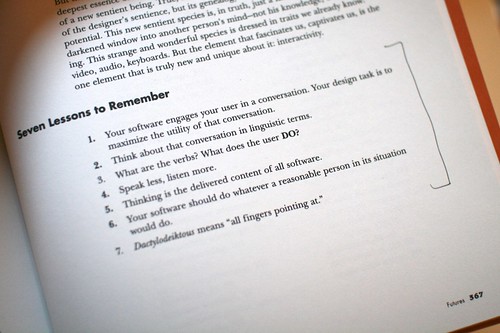Looking at interaction design metaphors lately, I've been reading Chris Crawford's "The Art of Interactive Design: A Euphonious and Illuminating Guide to Building Successful Software". As mentioned in this other blogpost, I like his approach that uses verbs:
Using linguistics as a metaphor for HCI/interaction design is of coruse very old and other people than Crawford proposed similar approaches. However, the idea of focusing on verbs (what people can do) in design is interesting and used here and there. See for example the recommendation #2 in Jyri Engeström's slides about designing social software ("define your verbs").
As appealing as it is, I found an interesting quote in Howard Becker's book "Telling About Society" that (IMHO) explain my interest in verbs:
"it's a confusing error to focus on nouns rather than verbs, on the objects rather than the activities, as though we were investigating tables or charts or ethnographies or movies. It makes more sense to see artifact as the frozen remains of collective action, brought to life whenever someones uses them - as people's making and reading charts or prose, making and seeing films. We should understand the expression a film as shorthand for the activity of 'making a film' or 'seeing a film'."
(Thanks Basile for pointing this out)
Why do I blog this? Material for my interaction design course about user observations and design. This notion of verbs is interesting given its 2-facets: you can design something by using the verb metaphor (you then define verbs that set what people can do) and study how people employs the designed artifacts by studying what they do (which is defined by the verb). The action, defined by the verb, is more important than the artifact (defined as a noun) itself.